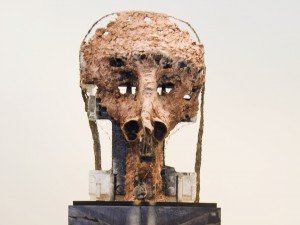17/11/2012
Two exhibitions
MoMA PS1, New York
Huma Bhabha is known for her engagement with the human figure and for her use of found materials, working primarily in sculpture. Bhabha creates figures that feel unstable and ephemeral. Thomas Lanigan-Schmidt's mixed-media constructions, collages, and installations are marked by a trashy opulence concocted from household items and dollar stores.

Huma Bhabha
Unnatural Histories
Huma Bhabha (American, b. Karachi, Pakistan, 1962) is known for her engagement with the human figure and for her use of found materials, working primarily in sculpture. Often tending towards the grotesque, Bhabha’s sculptural works and photo-based drawings feature bodies that appear dissected and dismembered, but one can likewise view them as monuments to human life reclaimed from the detritus of a post-apocalyptic landscape. Incorporating materials like Styrofoam, animal bones and clay, Bhabha creates figures that feel unstable and ephemeral. Insistently contemporary, they nevertheless recall classical figurative traditions across a range of cultures and historical periods, typifying a strand of neo-primitivism that has arisen in the past decade.
Organized by Peter Eleey, Curator, MoMA PS1, with Lizzie Gorfaine, Curatorial Assistant.
Huma Bhabha: Unnatural Histories is made possible by MoMA’s Wallis Annenberg Fund for Innovation in Contemporary Art through the Annenberg Foundation.
Additional support is provided by The International Council of The Museum of Modern Art and by Marilyn and Larry Fields.
Special thanks to Lawrence B. Benenson.
----
Thomas Lanigan-Schmidt
Thomas Lanigan-Schmidt’s mixed-media constructions, collages, and installations are marked by a trashy opulence concocted from household items and dollar stores. Mimicking Byzantine decoration with cellophane, aluminum foil, tinsel and glitter, Lanigan-Schmidt (American, b. 1948) pioneered a maximalist aesthetic in the late 1960s that explored gay sexuality, class struggle, and religion. Mingling high with low, and sacred with profane, Lanigan-Schmidt bucked the reductive tastes of conceptualism and minimalism that dominated his youth, creating a radically decorative practice that, despite its influence, has never been properly assimilated into the history of American art.
Organized by Peter Eleey, Curator, MoMA PS1, with Jocelyn Miller, Curatorial Assistant.
The exhibition is made possible by the MoMA PS1 Annual Exhibition Fund.
Image: Huma-Bhabha, Twins
MoMA PS1 press contact:
Rebecca Taylor, Communications Director (718) 786-3139 rebecca_taylor@moma.org
MoMA PS1
22-25 Jackson Ave. at the intersection of 46th Ave. Long Island City, NY 11101
Hours
12–6 PM, Thursday through Monday, closed on Tuesdays and Wednesdays.
MoMA PS1 is closed in recognition of the following holidays: Thanksgiving, Christmas and New Years Day. On Christmas Eve MoMA PS1 closes at 3 p.m.
Admission is suggested: $10 for adults; $5.00 for students and senior citizens; free for MoMA members, MoMA Corporate Members, MoMA admission ticket holders, Long Island City Residents



